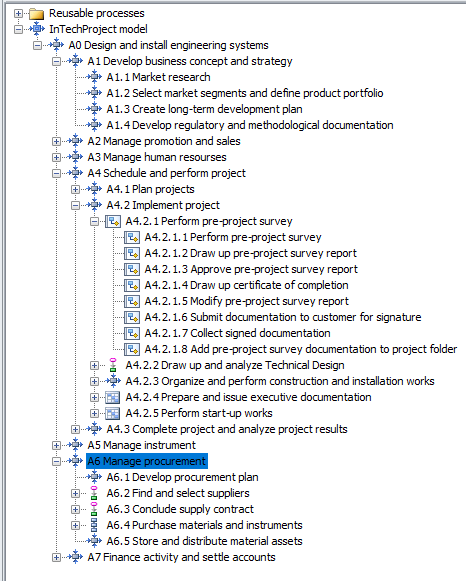How to create an effective system of organizational development based on a formalized business model and minimize operational risks in the company? How to involve employees in the process of modeling their activities and motivate them to achieve results? Consultants from the ________________ team, who have extensive experience in implementing process management, will talk about their experience.
Keywords: development of a process model, standard processes, description of business processes, describe the business processes, not formalized business processes, top-level process model, Business Process Modeling, business process improvement, improve the process, minimize operational risks, implementing process management, Increase manageability, maturity of the processes, poorly formalized processes, blurred lines of responsibility, effective cross-functional interaction, process-oriented risk management system, Generate a knowledge base, Business Modeling Agreement, risks of business processes, expected process risks, define performers of process steps, implementation of process management, identify process loops, reduce process costs, optimization of the organizational structure, identify non-optimal process
— What companies refer to you with a request to “get their business in order”? How do they describe their needs? What makes them change their standard approach to management?
Many organizations at a certain stage of development encounter a situation where, on the one hand, the business and scale of activities are growing, but the manageability of these very activities is declining. Often this is due to the low level of maturity of the processes within the organization. The symptoms of this problem vary.
Examples include poorly formalized processes, imperfect business logic of processes, blurred lines of responsibility, staff unawareness of documents and requirements. Often our customers’ regulatory framework exists in the form of scattered text documents with different structures and different levels of detail. The documents describe functions of individual departments and contain no information about interaction of different departments (full process chain). Also, information about a person responsible for the result can rarely be found in such documents. There is no “common business language” for employees. Under such conditions, further development of the company requires a fundamentally different approach to building a management system.
From our point of view, the main purposes of such “to put things in order” projects include consolidation of responsibility areas and increasing the interest of employees in the results of their work. These objectives can be detailed in a list of specific tasks:
- Optimize the corporate management system, make it transparent to the management and responsive to changes in the internal and external environment;
- Ensure effective cross-functional interaction of departments when performing business processes;
- Update the regulatory documentation;
- Disseminate the process approach philosophy;
- Develop a process-oriented risk management system;
- Generate a knowledge base on company activities.
— What does your typical project look like? What are its stages? What does the client team need to consider at the start?
We recommend setting up a separate business unit or employee (depending on the size of the company) who will lead the project team. This business unit or employee will provide methodological, technical and informational support concerning implementation of business processes.
The following stages are typical for our projects:
- Develop a tree of all business processes.
- Assign owners to the processes.
- Rank the processes, develop a description schedule.
- Develop a “Business Modeling Agreement”.
- Develop a “Regulation on Business Processes” normative document.
- Conduct trainings on process management for employees.
Figure 1 shows a sample Business Process Tree:
Figure 1. Sample Business Process Tree
Next, we rank all business processes to prioritize development of business process flowcharts. At this stage you need to select the level up to which you will decompose business processes. The processes should be described in such details that any new employee could have taken business process flowcharts together with the attached relevant regulatory documents and software memos, and understand his/her duties without additional instructions.
Based on the ranking results, a schedule of process descriptions is developed. This schedule should be closely monitored then: a report on compliance with this schedule should be submitted to the top management quarterly.
Processes are ranked according to the following criteria:
- Process importance to business / business process revenue (on the 1 to 5 scale: 1 — less important, 5 — more important).
- Problems in process performance / number of claims / complaints / operational risks (on the 1 to 5 scale: 1 — rare problems, 5 — many problems).
Adding up the scores of the two criteria results in a description schedule: processes with a higher total score should be described first.
In order to get standard process descriptions, we recommend that you develop the “Business Modeling Agreement” document first. It defines the basic rules of business process description, specifies notations that should be used for process description and contains the basic list of terms. Also, a template for a process description should be developed and used. This will ensure all employees speak the same “business language”.
We use Business Studio software for process description. And as soon as we develop a process model we provide training and advice to process owners and business analysts on using this software. All the process descriptions are agreed by process participants, and approved by top management.
— What challenges do you and the customer’s team usually face when implementing a process approach? Tell us about good practices you have developed to overcome these difficulties?
As a rule, we face general resistance of the staff who doesn’t want to implement process approach, and as a result, lack of desire to disclosure process details, they try to simplify process flowcharts. Another problem is dissemination of information among employees (e. g. a business process is approved but no one knows about it).
However, we do know how to overcome these difficulties, largely due to the following innovative business process management practices:
1. Involvement of all departments in the process of developing an activity model
Any project dedicated to implementation of a process approach is mostly ideological, its purpose is to change the mindset of the staff from functional to process oriented. That’s why a lot of explanatory work is conducted on different levels including motivational, explanatory and training events on process management.
All employees are kept up-to-date on project progress by posting project-related news and publications at internal information resources, as well as by holding trainings. Every month we publish information on the project progress at the internal portal. This information includes optimization results (“small victories”) achieved while describing business processes and achievements of individual participants.
The interest and support of top management is very important when implementing process approach: the budget for the project is allocated, employees are trained, there is a responsible employee or business process management unit, strategic sessions on the project (with participation of top managers) are held, etc.
Normatively, the explanatory work should be supported by the “Regulation on Business Processes” document that describes how business process management system is developed in the Bank, and how the rights and obligations of the Bank’s employees are distributed when implementing the process approach. Job descriptions of each employee should be modified in accordance with these new rights and obligations.
2. Generation of the communication environment for employees on the basis of an integrated business model
We recommend our customers use the business portal for the distribution of the reference documentation. The portal should contain the actual tree of business processes, organizational structure, normative documents, and the list of the software used.
Using the Portal, each employee can easily obtain information about processes in which he/she is involved, find out information on processes which he/she is the owner for and/or developer; learn what new processes are approved; what software products and documents are used; what expected and manifested risks of business processes are defined.
The actual schedule of development and revision of processes with the indication of terms, owners, and responsible business analysts, is also placed on the Portal, so that everyone can see which processes need to be revised and in what terms.
When a new employee is hired, he or she is given access to the Portal to study the necessary business processes and documents and to get to know the employees. Knowing the processes of an employee, it is easy to define the list of documents and software he/she needs access to. This data is also used to develop the training plans for new employees.
Figure 2. Sample Business Process Tree
3. Integration of business process management with operational risk management
While describing each business process, the owner defines the expected process risks, and indicates preventive actions and control points (functions which are considered as high-risked, and require special attention when training the personnel and developing knowledge tests for employees).
The Portal displays new risks (process, personnel, performance) and their relationships with business processes. This enables process owners to monitor the risk dynamics of their processes (see Figure 3).
Figure 3. Report on the Portal on the actual and expected process risks
Thus, management representatives can constantly analyze the risks revealed, and manage actions to minimize these risks and to optimize the processes.
4. Comprehensive personnel assessment based on business process modelling system data
Many customers need to get reports on a complex estimation of each employee (list of trainings, test results, personnel’s risks). In addition, for front-office employees, data on customer satisfaction as well as service behavior of employees should be gathered in the form of reports.
5. Using roles when defining performers of process steps
It is not rare that organizational structures of our customers change. Thus, we recommend not to specify exact positions or departments when defining performers for process steps, but to use roles instead. Roles in their turn include exact positions, and each position is related to an employee (a person).
In this case changes of the organizational structure like modification of a position’s name or transferring of an employee to another department, do not affect the process model, it stays up-to date. This allowed us to significantly reduce time of applying such changes to the business system.
— What changes do your customers notice after implementation of process management practices?
We consider the 100% involvement of personnel in the project and significant improvement in communication between employees to be our main achievements.
We optimize many processes. It is rather easy to identify process loops and non-optimal process steps when developing graphical process models.
Another effect is the optimization of the organizational structure. This is achieved by reviewing the logic of business processes and a more rational distribution of functions between employees.
In general, all customers mention that with implementation of process management they get greater transparency in management of activities at all levels and reduce process costs.
December 2022




